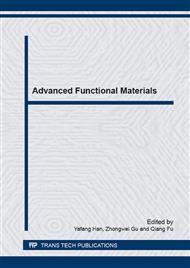p.49
p.54
p.61
p.67
p.72
p.76
p.80
p.89
p.97
Study of Black Center in Silicon Wafer for Solar Cell
Abstract:
The center of czochralski (CZ) wafer for solar cell often has black center, due to the existence of high impurities content, many defects such as dislocations. This has serious effect on solar cells’ conversion efficiency. To solve this problem, we developed a new kind of material-czochralski and floating zone (CFZ) silicon. But there is still black center in the CFZ-Si wafer with conventional process. In order to solve this problem successfully a new technology-alternant forward and reverse rotation was introduced. By testing the crystal defects, metal and oxygen impurities content, it has been found that the black center is related to oxygen distribution in the wafer. However since the content was very low and not enough to affect the solar cells’ conversion efficiency, which has been testified in solar cell. Therefore CFZ technology offers a new kind of silicon material, which can avoid the black center problem in CZ silicon wafer.
Info:
Periodical:
Pages:
72-75
Citation:
Online since:
March 2015
Authors:
Keywords:
Price:
Сopyright:
© 2015 Trans Tech Publications Ltd. All Rights Reserved
Share:
Citation:


